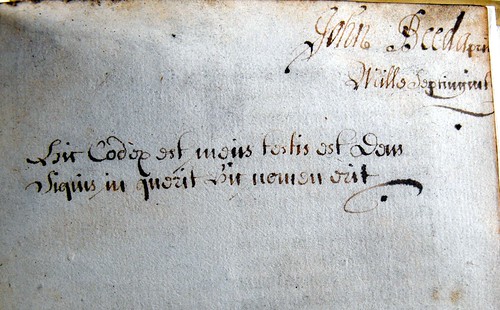Bindo de Senis: Aurea Biblia, sive Repertorium aureum Bibliorum.
[Cologne: Ludwig von Renchen, c. 1487]
4to. a-t8 v-x4 y8. [168] leaves (y6-8 blank).
ISTC ir00018500; Polain(B) 3298 = 3299; Bod-inc B-345E; CIBN R-14.
Entered jointly under Antonius Rampigollis and Bindo de Senis by ISTC; according to Goff the prologue only is by Rampigollis, the text by Bindo de Senis.
Proctor assigned to [Strassburg: Printer of Vitas Patrum].
| GIP number: | B74 |
| Shelf-mark: | Sp Coll Hunterian Bx.3.39 (see main library entry for this item) |
| Provenance: | Johannes Byll or Hyll (16th/17th century): partially deleted inscription ‘Johan[ne]s [b?]yll (alias) Schysbury(?)’ on a1v. John Reed (or perhaps Beed) (fl. 1700): ‘Liber Johanes R(?)eed Aprill the 20 1700’ on a1r; name repeated on the one surviving final blank leaf ‘John R(?)eed’ followed by a cropped date and the annotation ‘Hic codex est meus testis est deus || Siquis in querit hic nomen erit’. John Ratcliffe (1707-1776), book collector: sale (1776), lot 1355 (‘compendium biblie quod aureum alias biblie reportorum nuncupatur’). William Hunter (1718-1783), physician and anatomist: purchased for £0.3.6 at the Ratcliffe sale; see the annotated British Library copy of the sale catalogue. Hunterian bequest 1807; Hunterian Museum bookplate on front pastedown, with former shelfmark “An.7.12”. |
| Binding: | Scotland, rebound in parchment Dec. 1966, by Ernest Riley, replacing a binding of quarter goatskin; spine lettered in gold; new plain endpapers; marbled paper sides; earlier gilt-edging of leaves retained; binder’s note loosely inserted at end. Size: 190 x 138 mm. |
| Leaf size: | 180 x 129 mm. |
| Annotations: | Evidence of single letters of the alphabet added in dictionary order, in an early hand, to the top corner of recto leaves as a means of navigating the text; large letter “C” in ink in top right hand corner of a1r; partially read inscription in top margin of a1r “p[er] d. [...] p[ri]mariu[m](?)”. |
| Decoration: | Initials added in brown ink. |
| Imperfections: | Wanting leaf y2 and two of the three blank leaves at the end of quire y. |





